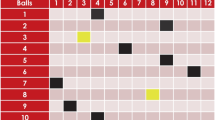Abstract
Letn distinguishable balls be placed randomly inton cells. IfM n denotes the maximal number of balls falling into the same cell, it is shown that asymptoticallyM n only attains two values: There is a sequencem n of integers such thatP(M n=mn orM n=mn+1) tends to 1, asn→∞.m n is determined explicitly and asymptotically.
Similar content being viewed by others
References
Feller, W.: An Introduction to Probability Theory and Its Applications, Volume I. 3. Ed. New York: J. Wiley. 1968.
Johnson, N. L., Kotz, S.: Urn Models and Their Application. New York: J. Wiley. 1977.
Levin, B.: A representation of multinominal cumulative distribution functions. Ann. Statist.9, 1123–1126 (1981).
Rényi, A.: Three new proofs and a generalization of a theorem of Irving Weiss. Publ. Math. Inst. Hung. Acad. Sci.7, 203–214 (1962).
Author information
Authors and Affiliations
Rights and permissions
About this article
Cite this article
Stadje, W. A nearly degenerate random variable occurring in an occupancy problem. Monatshefte für Mathematik 108, 201–209 (1989). https://doi.org/10.1007/BF01308671
Received:
Revised:
Issue Date:
DOI: https://doi.org/10.1007/BF01308671



